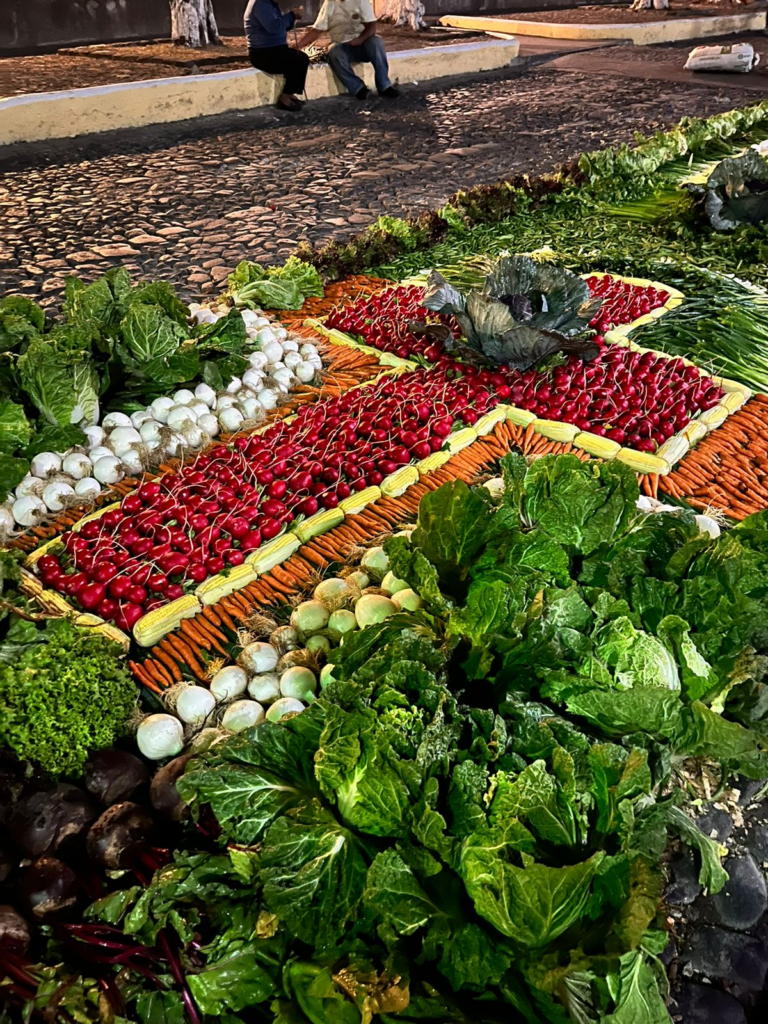Spending the Holy Week in Guatemala was the most animated and spectaculars experience that I will live to remember. I truly loved the whole experience, especially the beauty along with the creativity of the carpets (Alfombras) and the religious procession. These Guatemalan intergenerational rituals put forward a distinctive heritage in addition to its uniqueness.
The creation of the ‘Alfombras’ (Carpets)is one of the most beautiful traditions in the Holy Week. Guatemalans create them to show their devotion, gratitude, and love towards Jesus. The Alfombras are made from sawdust, vegetables, flowers, fruit, palm leaves, and paper, and are laid out in the streets. Neighbors work together to create artistic impressions. The sawdust must be constantly sprayed with water to ensure that it doesn’t fly away. They are accustomed to being walked over by religious processions; these tradition holds a significance like Jesus riding a donkey to Jerusalem (Palm Sunday). Alfombras can also be seen in other parts of Latin America but not as much as in Guatemala.
Religious processions can be observed in various places around Guatemala in the lead up to Easter Sunday. It is stunning how each day has its own singularity of different clothing, music, and statues. The most detailed processions take place in Antigua, drawing thousands of locals and tourists to the city. I had a unique opportunity of witnessing a live procession here in Barcenas on good Friday that illustrated Jesus carrying the Cross followed by our lady of sorrows and watched the rest on the TV. Some of the “Andas” (floats) are so long (and heavy) that they require more than 50 men to carry them.

According to the Guatemalan history, the Holy week’s celebration is an exceptional one since it combines pre-Columbian elements with Catholic beliefs imported by the Spanish more than five centuries ago. The Catholic passion that exists in Guatemala today has almost magical, mystical overtones and that is why Holy Week in this country has no comparison in the world. These and other reasons led the United Nations Educational, Scientific and Cultural Organization (UNESCO) to declare it Intangible Cultural Heritage of Humanity shared Sister Juana Z. Mendoza MSC.
Guatemalan Holy Week is syncretic. That is, the meeting and reconciliation of different beliefs and doctrines. In this case, they combine elements of the Mayan culture and Catholicism, brought from Europe. Guatemalan Holy Week draws together many symbols such as the passion, death, and resurrection of Christ as much as other parts of the World. In addition, this religious festival has unique characteristics in Guatemala. This makes it superb and emblematic. Finally, but not least, I give a lot of credit and thanks to my community members (Sisters Ana Jilma, Juana Mendoza, Maria Elena and Sonia Osorio), the staff at Dispensario Madre Cabrini and my Spanish teacher (Alejandra Rodriguez) for sharing Guatemalan culture and its significance with me.
~ Thanks to Evarlyne for this witness


Thanks Evarlyne for sharing this devotional and beautiful Holy Week tradition with us. The photos are so distinctive in that we can see the detail of each one. Know we are keeping you and the community in our prayers. God has graced you with the opportunity to learn the Spanish language with a wonderful teacher. Many God continue to bless you as you learn and minister in Guatemala. Please say hello to the sisters and know we are praying for you and the people of Guatemala. Sending my love. Don’t forget to come back.